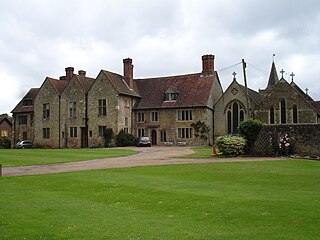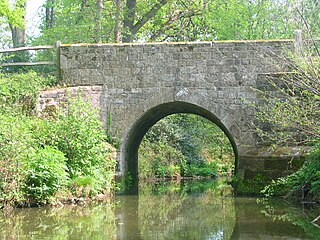
Petworth is a town and civil parish in the Chichester District of West Sussex, England. It is located at the junction of the A272 east–west road from Heathfield to Winchester and the A283 Milford to Shoreham-by-Sea road. Some twelve miles (21 km) to the south west of Petworth along the A285 road lies Chichester and the south-coast. The parish includes the settlements of Byworth and Hampers Green and covers an area of 2,690 hectares. In 2001 the population of the parish was 2,775 persons living in 1,200 households of whom 1,326 were economically active. At the 2011 Census the population was 3,027.

The River Rother flows from Empshott in Hampshire, England, to Stopham in West Sussex, where it joins the River Arun. At 52 kilometres (32 mi) long, most of the river lies within West Sussex except for the first 10 kilometres (6.2 mi) which lie in Hampshire. The upper river, from its source to Midhurst, has been used to power watermills, with the earliest recorded use being in 1086, when the Domesday survey was conducted. Although none are still operational, many of the buildings which housed the mills still exist, and in some cases, still retain their milling machinery. This upper section is also noted for a number of early bridges, which have survived since their construction in the fifteenth, sixteenth and seventeenth centuries.

Midhurst is a market town, parish and civil parish in West Sussex, England. It lies on the River Rother 20 miles (32 km) inland from the English Channel, and 12 miles (19 km) north of the county town of Chichester.

The A272 is a road in southeast England. It follows an approximate east–west route from near Heathfield, East Sussex to the city of Winchester, Hampshire.

Fernhurst is a village and civil parish in the Chichester District of West Sussex, England, on the A286 Milford, Surrey, to Chichester road, 3 miles (4.8 km) south of Haslemere. The parish includes the settlements of Henley Common, Kingsley Green and Bell Vale, lies within the boundaries of the South Downs National Park and is surrounded by hills.

Easebourne is a village, Anglican parish and civil parish in the Chichester District of West Sussex, England. It is half a mile (0.8 km) north of Midhurst, across the River Rother on the A272 and A286 roads. The parish includes the hamlet of Henley to the north. In the 2001 census there were 708 households with a total population of 1,717 of whom 785 were economically active.

Selham is a small village and former civil parish, now in the parish of Graffham, in the Chichester district of West Sussex, England. It lies south of the A272 road 3 miles (4.8 km) east of Midhurst. It is mainly in the parish of Graffham, but partly in that of Lodsworth to the north. In 1931 the parish had a population of 65.

Iping is a village and former civil parish, now in the parish of Stedham with Iping, in the Chichester district of West Sussex, England. It lies just off the A272 road 2 miles (3.2 km) west of Midhurst, on the River Rother. In 1931 the parish had a population of 400.

Stedham is a village and former civil parish, now in the parish of Stedham with Iping, in the Chichester district of West Sussex, England, on the A272 road 1.5 miles (2.4 km) west of Midhurst. In 1961 the parish had a population of 649. On 1 April 1974 the parish was abolished and merged with Iping to form "Stedham with Iping".

Trotton with Chithurst is a civil parish in the Chichester district of West Sussex, England. Trotton is on the A272 road 7 miles (11 km) west of Midhurst. Chithurst is about 1 mile (1.6 km) north west of Trotton. The parish also contains the hamlet of Dumpford.

Rogate is a village and civil parish in the Chichester district of West Sussex, England, in the Western Rother valley. The village is on the A272 road 5.6 miles (9.0 km) west of Midhurst and 5 miles (8.0 km) east of Petersfield, Hampshire. The civil parish includes the villages of Rogate and Rake and the hamlets of Haben, Fyning, Hill Brow, Langley, Durford, Wenham, Durleighmarsh and Terwick Common.

The A286 is an A class road in the south of England, from its northernmost point in Milford, Surrey, to Birdham, West Sussex. It passes through the market towns of Haslemere and Midhurst, and the cathedral city of Chichester. The road is mostly single carriageway, with a small dual carriageway section as part of the Chichester ring road.
The Midhurst Railways were three branch lines which were built to serve the market town of Midhurst in the English county of West Sussex. The three lines were the Petersfield Railway, from Petersfield; the Mid-Sussex Railway extended by the Mid-Sussex and Midhurst Junction Railway, from Hardham Junction (Pulborough); and from Chichester. The Petersfield Railway opened in 1864, the promoting company having been absorbed by the London and South Western Railway (LSWR) in 1863. The Mid-Sussex lines reached Midhurst in 1866, after being absorbed by the London, Brighton and South Coast Railway (LBSCR) in 1862. The two lines did not connect, and there were two separate stations close by one another. The Chichester line took much longer to complete, and was opened in 1881, and a new LBSCR station was opened, replacing the first station. In 1925 the former LSWR line was connected to that station.

The River Lod is a short river draining about 52 km2 (20 sq mi) of north west Sussex. The main source is on the Greensand Ridge at Marley Heights near Haslemere, about 140 metres (460 ft) above sea level. From here it flows west past Lynchmere, then south to Furnace Pond, where iron cannon were cast during the English Civil War. It then turns south east, flowing south of Fernhurst to Lickfold and Lurgashall where it formerly powered Lurgashall Mill, now moved to the Weald and Downland Open Air Museum. From Mill Farm it heads south between high banks, which it only overflows after the heaviest of rainfalls, passing between the hills of Lodsworth and River to Halfway Bridge on the A272 road then joining the River Rother at Lods Bridge.

Fittleworth is a village and civil parish in the District of Chichester in West Sussex, England located seven kilometres (3 miles) west from Pulborough on the A283 road and three miles (5 km) south east from Petworth. The village has an Anglican church, a primary school and one pub, The Swan. It is within the ancient divisions of the Bury Hundred and the Rape of Arundel. The village is bounded south by the Rother Navigation.

Stopham is a hamlet and civil parish in the District of Chichester in West Sussex, England, about 1.5 miles (2.4 km) west of Pulborough on the A283 road. It is in the civil parish of Fittleworth.

Rotherbridge is a small, rural community situated approximately 1 mile (1.6 km) south-west of Petworth in West Sussex, England. Until 1800, the road from Chichester to Petworth crossed the River Rother by a bridge here; the river acquired its present name from the bridge. Rotherbridge also gave its name to the Hundred of Rotherbridge which comprised several of the surrounding villages, as well as the town of Petworth.

Coultershaw Bridge is a rural community situated 1.5 mi (2.4 km) south of the town Petworth in West Sussex, England where the A285 road from Petworth to Chichester crosses the River Rother.





















